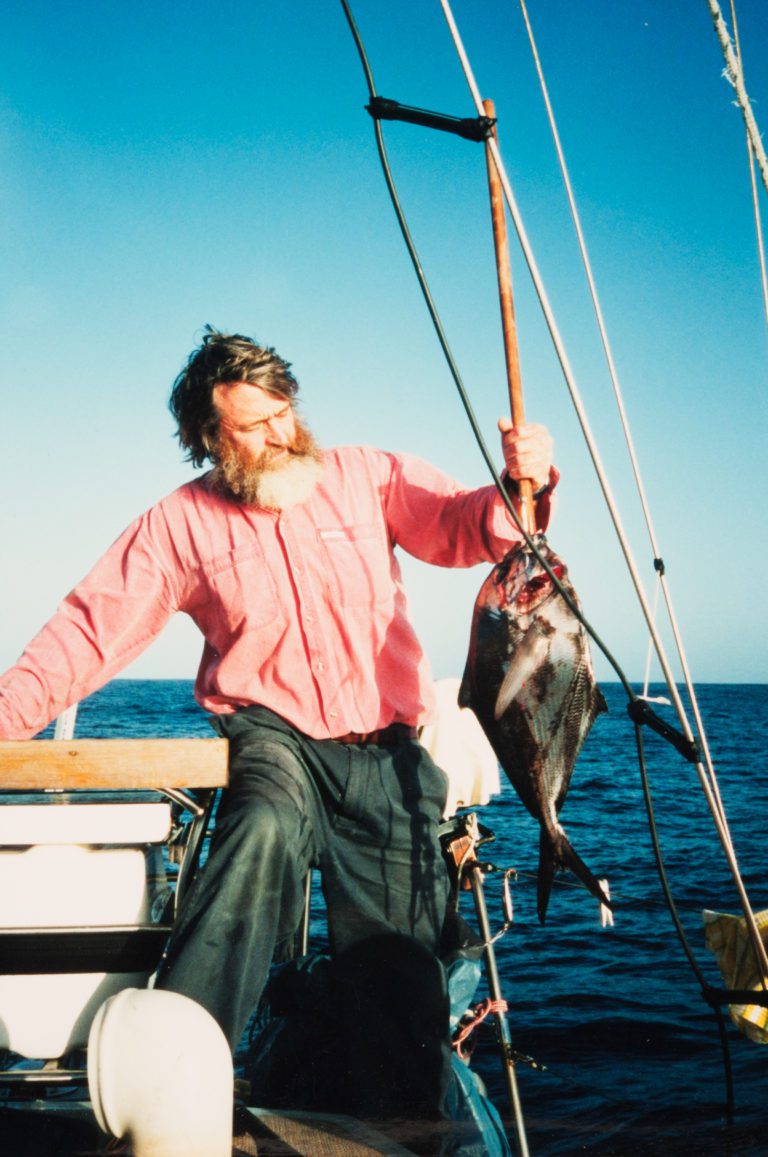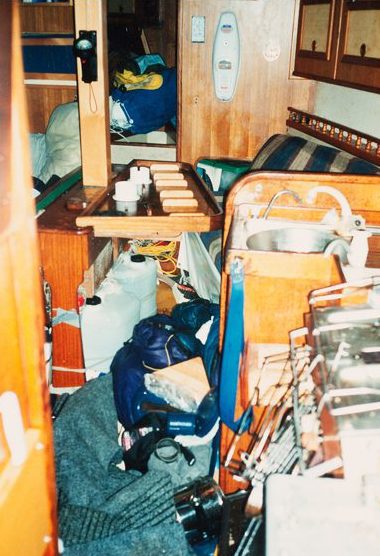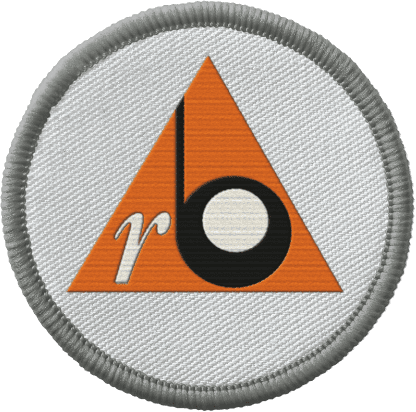We were running under a storm jib, 500 miles west of St Paul Island, a speck of volcanic rock in the middle of the Indian Ocean, approximately halfway between South Africa and Australia. All around me was madness.
I was huddled under a dodger, trying to stick some kalamata olives and parmesan cheese onto peanut butter on a biscuit and not get pitched over the side by a wave. Having photographed the 1998 Sydney-Hobart storm, I thought a long ocean voyage on a small yacht would help me to understand yachting better. This better understanding, I hoped, would be reflected in the subtlety of my photographs. That was the theory anyway, and it explained what I was doing in the middle of the Indian Ocean, eating crunchy peanut butter on biscuits on a 35-foot yacht in a hurricane.

In May 2001, I met the retired doctor and good friend Dr Joe Cannon and retired businessman John Wedd in Cape Town, South Africa, to commence an Indian Ocean passage from Cape Town, South Africa, to Fremantle, Australia. It was the last part of a nine-month eastbound circumnavigation by Joe. At 77, Joe was as sprightly and healthy as a man 25 years younger.
I had been tempted to accompany him for the entire voyage at his invitation. But he was leaving Australia in October 2000, so going on the circumnavigation would mean I wouldn’t be able to photograph the annual Sydney – Hobart race in late December. I have documented the race since 1974 and didn’t want to break my streak. So, I elected to join him for the final stretch instead.
Our other shipmate John, at 63, was a veteran sailor and a good friend. After cruising the coast of Chile, they rounded Cape Horn and stopped at the remote island of Tristan de Cunha before arriving in Cape Town, South Africa, where I met them. Aboard Joe’s 1885 35-foot Martzcraft ketch “Avalon of Tasman”, a sturdy Australian-made fibreglass boat, the three of us set off for the Indian Ocean.


The worst weather that we could imagine
We were desperately hoping for a high to follow the series of lows we had been sailing through, with a clearing southerly to let us see the sun. A month into the voyage, the series of lows had been relentless. But the wind had slackened off a bit, easing to 45 knots and then down to 30 knots as we approached the centre of the low that had been dogging us for the past 48 hours…
It felt nearly calm, a respite from the 60-knot north-westerlies slamming us all through the previous night. The bottom had seemingly dropped out of our barometer, which was reading below 1004 hectopascals. With a wind shift to the southwest, the barometer came back up to 1010, and the wind freshened to 45 knots. When the southerlies eventually arrived, they were much stronger than we had hoped – gale force winds of 40 to 50 knots (around 90km/hour).
By daybreak, the wind had eased somewhat, but big lenticular clouds to the south suggested the worst was yet to come. By midday, the wind was storm-force, blowing at 60 knots, finally backing to the southeast. We decided to try to ride out the storm and realised that our planned arrival at St. Paul Island, roughly the halfway point to Australia, would be set back a few days.
The next day, the wind dropped a bit, and the state of the sea was something less than terrifying. We were, however, 100 miles north of our course, and without a change in the wind direction, we feared we wouldn’t be able to make St. Paul.
We reached across the southerlies for the next two days, and on June 11th, our 30th day at sea, the sunrise was glorious. Despite the beauty of the morning, I was worried after looking at the barometer, which read 1002 hectopascals. I was confused. We had just had such terrible weather with a high reading of 1024, and now things looked fair as it went down. It all seemed to be in reverse. Still, I felt confident in our little boat, even though things were getting pretty damp down below, thanks to all the water over the deck and the three of us coming off watch dripping wet.
Storm number two – the rollover
John was on watch when we had our first knockdown. It was just past midnight on June 12th. He was drenched with water, so I relieved him. It was all I could do to keep the boat’s stern into the breaking seas, but we managed to keep riding over the waves.
At 4.00 am, Joe came back on watch, and I went below. Fifteen minutes later, I was in my berth when I was suddenly thrown across the cabin into a bulkhead.
I was completely disorientated and had begun to fumble around looking for some light when suddenly the cabin rotated another 180 degrees, throwing me around again like I was in a washing machine. The boat had popped back right side up.
The cabin was an absolute shambles. The carpet and the inspection hatches were on the leeward berth, and all the starboard lockers were empty. Their contents were scattered everywhere, and the bilge was full of crockery. The silverware had fallen behind the drawer, and later, we nearly had to dismantle the shelving to get spoons to eat with.

On deck, Joe’s experience was something else. When the boat went over, he hit the wheel and was knocked into a winch and the dodger (the enclosed structure that protects you and the cockpit from the elements). He cracked some ribs. Once the boat was upside down, he had fallen out of the cockpit into the sea. His Stormy Seas lifejacket had inflated, and he’d shot straight up, hitting his head on the bottom of the cockpit before the boat rolled upright, leaving him standing on his head in the cockpit, full of cold Southern Ocean water.
The damage topside wasn’t as bad as it could have been – the mast was still standing. The dodger was gone, swept away by the sea. Half the dorade vents were gone, leaving holes in the cabin. The anchor chain had fallen out of the chain locker- disappearing into the depths. Everything stowed in the cockpit was gone, including two torches. Down below, water was rolling around, drenching everything. The SSB radio was dead, literally dripping seawater. Most of the saloon lights were too wet to work.
Goodbye to St Paul
By 7.00 am, we were cleaned up enough to get underway, with a big leftover sea tossing us around. We stuffed socks in the ventilator holes, covered them with plastic and tied it all with fishing line. Everything was wet. Even the coffee cups in the rack were filled with seawater. After a short discussion, we decided to head for Fremantle rather than continue to St. Paul. The main reason for this was to avoid worrying our families excessively – we had been in touch every few days, but with the radio gone, there would be no word from us until we arrived back in Australia.
St. Paul Island is a speck of volcanic rock in the middle of the Southern Ocean, an extinct volcano that was to be a quick stop during our passage. It would have been the only land that we would see between South Africa and Australia. I had hoped it would provide some stunning photographs. I could see it all. The boat would lie at anchor in the middle of the flooded crater, and I would hike to the rim: low winter sunlight would come through the opening in the crater wall that is the entrance to the “harbour”, and I would have a truly unique photograph.
On deck the life raft was still bolted to the deck, but we had some long and uncomfortable moments thinking about what would happen if it was ripped from the deck by the sea. We thought about the big hole it would make in the cabin top and decided to stow it in the cockpit instead. We tied it in a spider web of mooring lines and jammed it in place with coils of warp.



Storm number three – the hurricane
One day after the rollover, in the middle of the night, the wind began picking up again. The barometer dropped to 1001, and by daylight, we had managed to start the engine and get our bow into the wind, even with seas breaking the length of the boat. Soaked to the skin, we eventually deployed the sea anchor off the bow. We paid out 30 metres of warp (the rope normally used for mooring a vessel) and put a leather chafe protector where the warp passed through the bow chock.
The seas looked like those of the 1998 Sydney – Hobart race, which I had observed from the Aero Commander. Joe estimated the wave height at 50 feet with 70 knots of wind (hurricane force). They looked dangerous and frightening, but they provided a good opportunity for photography.
With the sea anchor, the boat was nicely stabilised, and we could relax a little as the boat was now tending to itself. It felt a bit like being tied to a wall, pulling and relaxing against the warp.
After 19 hours, the wind changed direction, further confusing the seas, and as we were about to retrieve the sea anchor, it chafed through, disappearing immediately into the seas ahead. With the decision to get underway now made for us, I felt some relief. I wanted to get away from this part of the ocean that had produced three terrible storms, one after the other.
Storm number four – the most frightening night Joe had ever seen
On June 16th at 2.00 am, another storm hit us. I couldn’t believe it. Even with the storm jib, the boat was overpowered, so we went to bare poles.
At 8.30 pm, we were knocked down again, and everyone put on their foul weather gear, even when below. Before dawn, we were knocked down two more times in winds of 50 to 70 knots. It felt like being broadsided by a car at an intersection each time the waves smashed against the little hull. The wind veered west-northwest.
By the 18th, two days later, we were running to the northeast, with still more wind, now from the north-northwest at 70 to 80 knots – the strongest winds yet. We tried to control the boat, running under bare poles, but by midnight we were exhausted and tied the rudder amidships and went below.
Yet another day of stormy weather followed, and the barometer began climbing to 1005. When the wind slacked off to 55 knots, it seemed a reprieve. The wind shifted to the south, clearing the skies, and even though we had huge southerly swells and breaking crests, we managed to spend our first night free of anxiety in a week.
19 days to Fremantle
As we sailed the next relatively uneventful 19 days to Fremantle, I had much time to reflect. The passage had been an extraordinary experience.
This 5,000-mile passage across the Indian Ocean tested me. The demands were similar to a previous mountaineering expedition in Peru, where our team did 12 first ascents. In both cases, the team had to deal with isolation and the need to endure whatever weather came our way. We had each other’s companionship and relied on each other for support. We learned to cope in a positive way with hardship and benefited from it. Isolation at sea for two months was wonderful. I had time to think and take stock.
Our lives were literally threatened. I was angry with myself that I might sacrifice the next 20 years of my life for another silly adventure. I might not walk our daughters down the aisle. I realised more than ever how fortunate I am to have a wonderful family and friends, to live in the best part of the world and enjoy a perfect lifestyle. What a tragedy it would have been to sacrifice and bury all of that under a wall of water.
When we arrived in Fremantle, the customs agents came down with their dog to search the boat. I said I wanted to cuddle the dog. “He has a job to do first,” they said. When the dog was finished, I sat down on the dock at the Fremantle Yacht Club and had a cuddle with the dog. It felt very fine.
Header image credit: John Wedd
